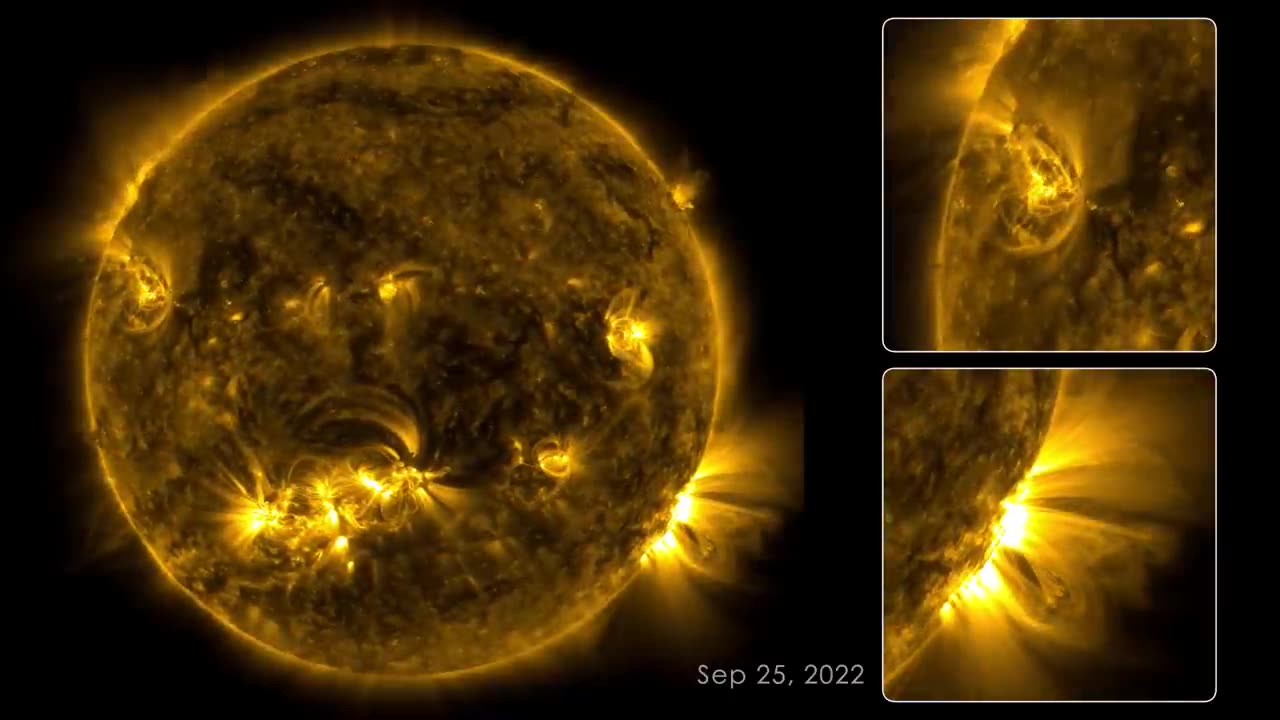Premium Only Content

133 Days on the sun
This video chronicles solar activity from Aug. 12 to Dec.
22, 2022, as captured by NASA's Solar Dynamics
Observatory (SD0). From its orbit in space around Earth,
SDO has steadily imaged the Sun in 4K x 4K resolution
for nearly 13 years. This information has enabled
COuntless new discoveries about the workings of our
closest star and how it influences the solar system.
With a triad of instruments, SDO captures an image of
the Sun every 0.75 seconds. The Atmospheric Imaging
Assembly (AIA) instrument alone captures images every
12 seconds at 10 different wavelengths of light. This
133-day time lapse showcases photos taken at a
wavelength of 17.1 nanometers, which is an extreme-
ultraviolet wavelength that shows the Sun's outermost
atmospheric layer: the corona. Compiling images taken
108 seconds apart, the movie condenses 133 days, or
about four months, of solar observations into 59
minutes. The video shows bright active regions passing
across the face of the Sun as it rotates. The Sun rotates
approximately once every 27 days. The loops extending
above the bright regions are magnetic fields that have
trapped hot, glowing plasma. These bright regions are
also the source of solar flares, which appear as bright
flashes as magnetic fields snap together in a process
called magnetic reconnection.
While SDO has kept an unblinking eye pointed toward
the Sun, there have been a few moments it missed.
Some of the dark frames in the video are caused by
Earth or the Moon eclipsing SDO as they pass between
the spacecraft and the Sun. Other blackouts are caused
by instrumentation being down or data errors. SDO
transmits 1.4 terabytes of data to the ground every day.
The images where the Sun is off-center were observed
when SDO was calibrating its instruments.
-
 LIVE
LIVE
Nerdrotic
49 minutes agoThe Great Hollywood MELTDOWN! A Culture War VICTORY Friday Night Tights 327 w/ Matthew Marsden
1,599 watching -
 LIVE
LIVE
In The Litter Box w/ Jewels & Catturd
19 hours agoThe Liberal Meltdown Continues | In the Litter Box w/ Jewels & Catturd – Ep. 687 – 11/8/2024
4,272 watching -
 1:34:20
1:34:20
Tucker Carlson
2 hours agoVivek Ramaswamy: Trump’s Sweeping Victory, & What It Means for the Future of Government Bureaucracy
31.1K87 -
![[Stream #12] Brand New Planet Coaster 2!! What Chaos Can We Cause??](https://1a-1791.com/video/s8/1/G/6/-/q/G6-qu.0kob-small-Stream-10-Brand-New-Planet-.jpg) LIVE
LIVE
OneRandomDolly
1 hour ago[Stream #12] Brand New Planet Coaster 2!! What Chaos Can We Cause??
665 watching -
 LIVE
LIVE
Twins Pod
17 hours agoThe Forbidden Technologies They Don't Want Us To Know About | Twin Pod - Episode 38 - Ashton Forbes
2,993 watching -
 1:42:10
1:42:10
The Quartering
3 hours agoTrump Drops NUCLEAR Plan To Eradicate Deep State, Kamala Harris In Hiding & Libs Still Melting Down
90.4K13 -
 4:32
4:32
BuddyBrown
6 hours ago $3.80 earnedMeet Our New ICE DIRECTOR Tom Homan! | Buddy Brown
14.7K6 -
 1:06:35
1:06:35
The New American
2 hours agoNew Global Reality | The New American Daily
23.8K2 -
 1:22:08
1:22:08
Russell Brand
5 hours agoTrump's Plan To DISMANTLE The Deep State + Biden & Dems Vow To "TRUMP PROOF" America! - SF489
178K170 -
 2:58:17
2:58:17
The Charlie Kirk Show
4 hours agoThe Trump Mandate + A MAGA Senate Agenda | Beck, Gingrich, Scott | 11.8.24
198K17